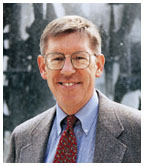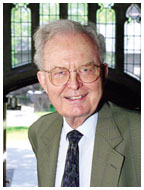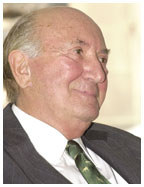June 9, 2004: Notebook
Alumni present Princeton Prize to three high school students
Andlinger Center for the Humanities dedicated

Washington, D.C., Princeton Prize recipients Jacqueline Akyea, far left, and Zainep Mahmoud, far right, were honored in May by Senator Paul S. Sarbanes ’54, second from left, U.S. Congressman John Lewis (honorary degree, 1987), center, and committee chairman Henry von Kohorn ’66. (Michael Barrett ’66) |
In 20 years of speaking with potential Princeton applicants, Henry von Kohorn ’66 met some of America’s brightest high school students, including several who were working to bridge racial and ethnic divisions in their communities. “I thought there ought to be a way to recognize their work, and Princeton ought to be able to play a part in that,” says von Kohorn, a former national chairman of the Alumni Schools Committee.
Less than a year after presenting that idea to Princeton administrators and fellow alumni, the Princeton Prize in Race Relations was born, with the goal of recognizing high school students who perform outstanding work to advance race relations in their high schools and communities. Boston and Washington, D.C., were chosen as pilot regions for the program, and in April, local prize committees selected three high school seniors as the inaugural Princeton Prize recipients from a pool of 55 applicants.
Shan Shan Nie of Boston’s Cohasset High School won the $1,000 Boston-area prize. Nie, who immigrated to the U.S. in 2000, organized cultural awareness workshops through the Coalition of Asian Pacific American Youth and encouraged teachers to add non-Western points of view to their classroom assignments. In Washington, the $1,000 prize was split between two winners, Jacqueline Akyea of Bethesda-Chevy Chase High School and Zainep Mahmoud of Benjamin Banneker High School. Akyea created “Unity Day,” an annual school program that features cross-cultural music, dance, and poetry and inspirational speeches from immigrant students. Mahmoud wrote a play, performed by the Young Playwright’s Theatre of Washington, about assaults and harassment of Muslims and people of Arab or South Asian descent after September 11.
In addition, nine other Washington students and 15 Boston-area students received certificates of accomplishment.
In 2004-05, the Princeton Prize will expand to include Atlanta, Houston,
and St. Louis, and von Kohorn’s goal is to support a nationwide
program using a network of alumni volunteers. Committee member Patricia
Irvin ’76 says that the Princeton Prize is not meant to recruit
applicants, but it does reflect the University’s commitment to issues
of race and ethnicity. Martin Gruenberg ’75, cochairman of the Washington
Schools Committee, says personal outreach from alumni volunteers helped
to make the prize’s debut successful. “I think this program
has the potential to develop a very special niche,” Gruenberg says,
“to recognize students doing this kind of work, and in turn encourage
other students.” ![]()
By B.T.
For a list of the student winners, go to www.princeton.edu/pr/news/04/q2/ 0420-prize.htm.

Professor Thomas Espenshade *72 (Olivia Starr) |
With colleges aiming to diversify their student bodies, underrepresented minorities have been given preferences in admissions, particularly at elite institutions. But how much is minority status worth? And how does it compare with other admission advantages, such as being a recruited athlete or a legacy? According to a new study by Thomas Espenshade *72, professor of sociology, the minority edge is comparable to the preferences for athletes and children of alumni.
In examining admission decisions at three unnamed private research universities, Espenshade found that African Americans and athletes enjoy the most significant bonus in admissions. Using the S.A.T.’s 1600-point scale as a measurement, Espenshade found that being black is worth roughly 230 extra points, while being a recruited athlete is worth 200 points. Hispanic applicants get an average bonus of about 185 points, and legacy status translates to 160 points. Asian applicants are at a disadvantage, comparable to a loss of 50 points.
The study is part of the multidimensional National Study of College Experience (N.S.C.E.), which is funded by the Andrew W. Mellon Foundation. Espenshade admits that relying on the numerical data of standardized test scores does not capture some important portions of the admission process. Admission officers have more information, including “soft variables” derived from personal statements and recommendations. “We’re looking at this with a set of binoculars where one of the lenses is not available to us, in some sense,” Espenshade says. “So we see partially, and I think the numbers that we come up with make generally good sense. But it’s only a partial story.”
In addition to expressing admission preferences in terms of S.A.T. scores, Espenshade’s research also tracks the likelihood of admission for the different applicant groups over time, from the 1980s through 1997, the last year of data included. Based on those statistics, the athlete advantage has shown significant growth, while advantages for African Americans and Hispanics are declining.
Looking at college admissions from a social scientist’s perspective could help to demystify some of the underlying mechanics of the admission process. The research also appeals to a wider audience outside academia. “There is a lot of interest in this topic of college admissions, simply because the competition to get into places like Princeton has become, among some segments of society, frenetic,” says Espenshade, who notes that Princeton is not one of the institutions that provided data for his work.
Espenshade’s paper on minority, athlete, and legacy preferences will be featured in an education-themed issue of Social Science Quarterly later this year. His current and future work on admission preferences also includes an examination of the impact of high school class rank and the quality of a candidate’s high school, and the N.S.C.E. is examining the impact of socioeconomic status in admissions.
Espenshade’s interest in diversity and higher education does not end with acceptance letters. When the Supreme Court upheld preferences for underrepresented minorities in Grutter v. Bollinger (2003), Justice Sandra Day O’Connor’s opinion of the court cited two primary reasons for permitting preferences: ensuring that the “path to leadership” is open to people of all races and ethnicities, and enabling the “substantial” benefits of diversity in education.
To reap the benefits of diversity, Espenshade says, patterns of social
interaction need to include the type of mixing and mingling that O’Connor’s
argument presupposes. Espenshade hopes that N.S.C.E. survey data will
give a clearer picture of how well friendships, roommate patterns, and
intergroup contact enable exchanges between people with diverse backgrounds.
“We need more empirical evidence on this question of whether there
are educational benefits to diversity,” Espenshade says. “I
think that in principle there are, but are we realizing that full potential?
Probably not.” ![]()
By B.T.

Beginning this fall prospective students will have the option to apply to Princeton by submitting the Common Application, along with a Princeton-specific supplement, in place of the University’s own application form, the Office of Admission announced in April. The Common Application and supplement will collect the same information as the current application, in a slightly different order, according to Dean of Admission Janet Rapelye. “Our goal is to reach out to as many potential applicants as we can,” she said.
Accepted by more than 240 colleges and universities nationwide, the Common Application enables applicants to save time by filling out one form that lists personal data, educational and testing background, work experience, extracurricular activities, and a personal statement. Harvard, Yale, and Dartmouth accept the application, with institution-specific supplements, and Cornell has announced that it will use the form next year. Since Yale began using the Common Application in 2001—02, it has seen record applicant pools, including more than 19,000 applicants in 2003—04. Princeton had a record 15,725 applicants in 2002-03, but that number dropped to 13,690 in 2003-04.
For Rapelye, use of the Common Application is part of a larger effort
to “broaden and deepen” the applicant pool. The University
also is reaching out to high school sophomores and juniors for the first
time, sending letters to students who have performed well on standardized
tests. ![]()
By B.T

Photo by Denise Applewhite |
Earl Miner, professor emeritus of English and Japanese literature, died April 17 after a long illness; he was 77.
Miner earned a bachelor’s degree in Japanese studies and master’s and doctoral degrees in English from the University of Minnesota. He was a member of the English faculty at Williams College from 1953 to 1955 and at the University of California—Los Angeles from 1955 to 1972. He joined the Princeton faculty in 1972 and retired as the Townsend Martin, Class of 1917, Professor of English and Comparative Literature in 2000. A specialist in early modern English literature, classical Japanese literature, and comparative poetics, Miner was awarded the University’s Behrman Award in 1993 for distinguished achievement in the humanities. He also received the Order of the Rising Sun from the Japanese government in 1994 in recognition of his commitment to Japanese literature.
Miner wrote numerous books that reflected his range of research specialties;
his recently completed book, Paradise Lost, 1668-1968: Three Centuries
of Commentary, will be published this summer. ![]()

Newman’s Day — an annual, unsanctioned event in which students try to drink 24 beers in 24 hours — created an unusually large uproar this year, after public safety officers confiscated 400 T-shirts advertising the event.
The officers, who removed the shirts from the dormitory room of Taylor Bright ’05, were acting on a request from Dean of Undergraduate Students Kathleen Deignan, who was concerned that the shirts promoted dangerous drinking. Deignan returned the shirts a week later, but not before Professor Andrew Appel asked his colleagues to condemn the seizure as censorship during the April 26 faculty meeting. At Appel’s request the resolution was tabled without further action.
Later, incoming provost Christopher Eisgruber ’83 issued the University’s stance on the incident: “We believe, in the words of former Supreme Court Justice Louis Brandeis, that when opinions are unpopular or controversial, the remedy, in general, is ‘more speech, not enforced silence,’ ” he wrote. “Prior restraints upon speech or publication – such as seizures of printed materials – should be clearly understood as an action of last resort, taken only under the most compelling circumstances.”
At the May 17 faculty meeting, President Tilghman said the University would have been “on solid ground” if it had announced in advance that the sale of Newman’s Day T-shirts would not be allowed because the shirts create a risk of “targeted, imminent harm.”
Newman’s Day, held April 24, was named for actor Paul Newman,
to whom students had erroneously attributed the quotation, “Twenty-four
hours in a day, 24 beers in a case – coincidence? I think not.”
The Philadelphia Inquirer eventually traced the quip to a 1986 “Willy
’n Ethel” comic strip. ![]()
By B.T.

Photo by Frank Wojciechowski |
Princeton’s new centrally located humanities hub, the Andlinger Center for the Humanities, was dedicated Friday, May 14. Comprising East Pyne, Chancellor Green, Joseph Henry House, and a new building currently called the Humanities Programs Building, the center was named for Gerhard Andlinger ’52, left, who gave $23 million toward the project.
After the dedication, the Council of the Humanities held a symposium
in Richardson Auditorium titled “Beauty,” in which a panel
of professors discussed the question, “Is it important, or desirable,
for artists to be mindful of beauty?” Composer Milton Babbitt *42
*92 examined changes in music, artist Frank Stella ’58 critiqued
the visual arts of the 20th century, and professor C. K. Williams discussed
the process behind his poetry. Creating beauty, he said, has never been
part of his daily work schedule. He concentrates on emotions, images,
and cadences, leaving the interpretation of beauty to the reader. The
symposium was moderated by Alexander Nehamas, professor of philosophy
and comparative literature. ![]()

In its second report, released April 30, the Task Force on Health and Well-Being recommended expansion or improvement of a range of University services, from mental health and preventive medical care to fitness and healthy eating. Specific ideas include changing the underused Frist Beverage Laboratory juice bar into a healthy eating café, and implementing screening programs to assist students, faculty, and staff with weight management, smoking cessation, alcohol and drug abuse, and other medical conditions. This summer, the committee will examine costs and prioritize recommendations in preparation for its final report, to be completed in the fall. More information can be found at www.princeton.edu/hwbtf/.
In 2003—04, Princeton’s full professors were the third-highest-paid
professors in the country, with an average salary of $145,600, according
to data compiled by the American Association of University Professors.
The average was $157,500 at Harvard and $155,800 at Rockefeller University.
![]()

Cuban Americans attending a lecture by Oliver Stone, whose new film profiles Cuban leader Fidel Castro, criticized the filmmaker for ignoring Castro’s imprisonment of political opponents and other human-rights abuses. Stone, father of Sean Stone ’06, spoke May 7 to a standing-room-only crowd in McCosh 10 following a rare public screening of his 2003 film Comandante. The film was set to air on HBO in May 2003 but was pulled after Castro executed three men who tried to hijack a ferry and flee to the U.S.
Stone responded to the criticism by citing comparable human rights records
of other Latin American leaders. When asked about life after Castro, Stone
predicted that Cuba would resist U.S. government influence. “The
question,” he said, “is will they resist McDonald’s?”![]()




